Disease Notes
Contact
Plant Diagnostician
Phone: (479) 575-2727
Email: ssmith@uada.edu
Jason Pavel
Diagnostician
Phone: (479) 575-7257
Email: jpavel@uada.edu
University of Arkansas System Division of Agriculture
Cralley Warren Building
Room 16
2601 N. Young Ave.
Fayetteville, AR 72704
Apple – Scab
by Sherrie Smith and Jason Pavel

Apple Scab on leaves– Venturia inaequalis
Photo by Sherrie Smith, University of Arkansas Cooperative Extension
Apple scab, caused by Venturia inaequalis, is the most economically important disease of apples in the United States. Severe crop losses may occur in areas with wet, cool springs.
What are the signs of apple scab?
Scab lesions may occur on fruit, leaves, blossoms, petioles, and peduncles, with the most obvious symptoms on the leaves and fruit. Lesions are often found first on lower leaves, and as leaves unfurl both sides may become infected. The spots are velvety brown to olive green with feathery edges. As the lesions age and become hardened, leaf malformation may occur.
Leaves that become completely covered with lesions yellow, shrivel, and fall from the tree prematurely. Infected fruit gets the same lesions and can become deformed and cracked. The fruit lesions eventually become dark brown to black circular rough spots.

Apple Scab on fruit – Venturia inaequalis
Photo by Sherrie Smith, University of Arkansas Cooperative Extension
How do you control apple scab?
Applications of Fruit tree spray every 7-10 days should be made from the tight cluster
stage until terminal shoot growth ends in midsummer. All fallen leaves and fruit should
be cleaned up. Dormant pruning of infected terminals aids in removing primary inoculum
but is time-consuming and can affect yield. This disease also affects crabapples.
For ornamental trees, sanitation and the application of fungicides containing chlorothalonil
are effective if started early.
Take Aways
- Plant resistant cultivars.
- Clean up all fallen leaves and fruit.
- Apply fungicides from the tight cluster stage until mid-summer.
This work is supported by the Crop Protection and Pest Management Program [grant no. 2017-70006- 27279/project accession no. 1013890] from the USDA National Institute of Food and Agriculture.